SAFElink Alliance: The Connected Site
The SAFElink Alliance project was, at the time, the largest two-way machine data site in the world. A wireless communication setup between the office and the 22 machine control plant created a connected site that allowed the project to gain a multitude of benefits.
Published: 12th May 2009
Author: Steed Shepherd - Machine Control Manager, SAFElink Alliance
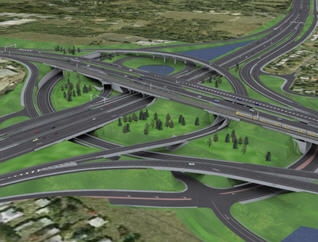
Project Overview
Constructed during 2008 to 2010, the SAFElink Alliance was a joint venture between the Queensland Government's Department of Main Roads; construction companies Leighton Contractors and BMD Constructions; and design firms Maunsell Australia and Arup, all joining forces to deliver the Ipswich Motorway Upgrade: Wacol to Darra project.
The project was an $AU700 million highway construction job located in Brisbane, Australia. It involves upgrading 7.6km (4.7mi) of two multi-lane motorways; a new multi-level interchange system; a new rail formation through the interchange that joined at either end to an expanding public transport system; over 5km (3.1mi) of new service roads; 26 bridge structures; as well as a new outdoor sporting complex and numerous pedestrian and cycle paths. The work involves moving approx 1.4 million cubic metres of bulk earthworks and over 420,000 tonnes of asphalt.

Project Machine Control
SAFElink Alliance employed the use of Trimble machine control across all work areas. The project utilised 22 GPS-guided machines including excavators, pad-foot compactors, bulldozers, and a smooth-drum roller as well as 8 graders that were able to switch between GPS and Total Station guidance.
The heavy use of machine control on site largely replaced the traditional survey pegs. The site relied heavily on the use of 3D guidance methods rather than the rows of batter boards and survey stakes. With such a heavy reliance on the machine control equipment, it became very useful to have the ability to monitor and communicate with the machines from a central location. From the very start of the project it was decided to enable all of the project's Trimble machinery with wireless communication.

Wireless: What Was Needed
It was a relatively easy exercise to establish the wireless communication between the office and the field machines.
On the machine side the project was able to use most of the existing hardware - they had already purchased full GCS900 softwares including the wireless option code and merely needed to turn the option on. They also needed to replace any 450MHz radios for 900MHz radios to enable more communication bandwidth. Interestingly, no licensing requirements are currently required in Australia for the 900MHz frequencies.
At the GPS base station, the project used the existing survey base receiver and output corrections for machine control through the SNB900. Because of the volume of machines and the requirement for faster transfer speeds, the project installed 4 SNB900's and split the machines evenly between them. These radios acted as the data gateway and were connected to the office PC through Ethernet. Additionally the project required another 4 SNB900's as repeater radios to continue the GPS base station broadcast to the extent of of the project works.
For those who aren't familiar with the Trimble products, Site Vision Office is the PC software that is used for importing and converting design files for machine use - and for exporting these machine files usually to a data card that can be loaded into the machine. In the office, SAFElink Alliance surveyors utilised the existing Site Vision Office software with the addition of a purchased wireless option code. The project also required 4 static IP addresses from the SafeLink IT department to ensure dedicated communication channels through the SNB900 radios.

Wireless: What Was Achieved
After installing all the necessary components, the project ended up with a wireless connection between the office and the field. This enabled a multitude of additional functions and benefits ...
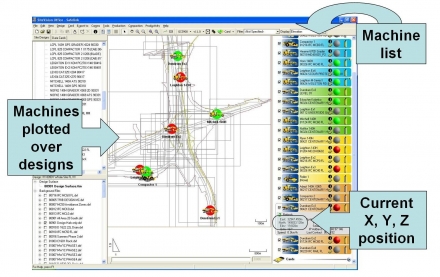
Where is the machine?
Where is the machine?
Determine machines current position:
- List of machines.
- Machines plotted over the selected design files.
- Current Easting, Northing and Elevation coordinates.
Useful for such things as:
- Determining which machines are working in which areas.
- Determining what design files could be required.
- Advising operator the name of the required design.
- Diagnosing GPS errors such as possible satellite visibility, radio connection, etc.
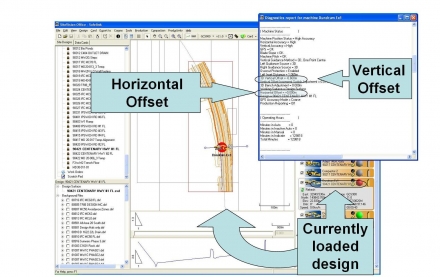
What design is it working on?
What design is it working on?
Determine what design is currently loaded:
- View the name of the currently-loaded design.
- View the machine plotted over the currently-loaded design.
- Determine any current horizontal and/or vertical offsets.
Useful for such things as:
- Determining that the correct earthworks staging's are being used in the field.
- Confirming that the latest design revisions are being used.
- Determining what box depths are being used on-site.
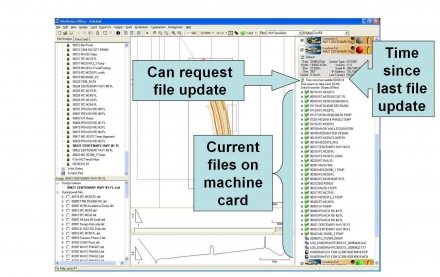
What design does it have?
What design does it have?
Investigate existing design files:
- Review current files on the machines data card from office.
- Includes a time since the last machine card update.
- Easily update the machine card file list.
Useful for such things as:
- Confirm that latest design files are available to the machine.
- Confirm that no superseded designs are available.
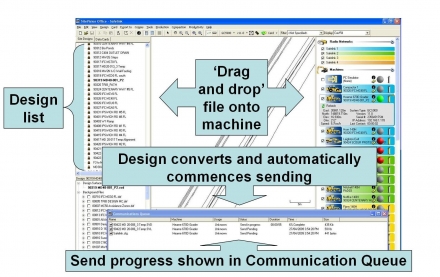
We need this design.
We need this design.
Send new design files:
- Select the required design from the design list;
- "Drag and drop" the file onto the required machine.
- Design converts and automatically commences sending.
- Send progress viewable in "Communication Queue".
Useful for such things as:
- Easily transfer new or revised design files from the office to the machines as soon as they are ready.
- No need to create new design card or travel out to each individual machine.
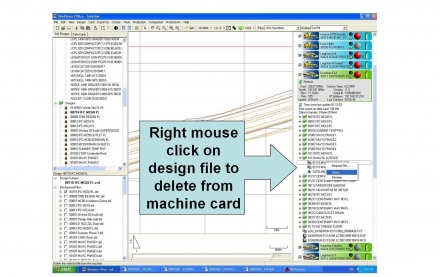
We don't need this design.
We don't need this design.
Remove design files:
- Easily remove designs from a machine card by right mouse clicking on desired files.
Useful for such things as:
- Ensuring intended design changes are not missed in the field by using a superseded design.
- Less files for the machine operator to sort through when changing designs.
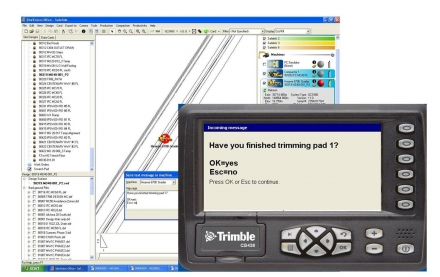
How does the operator know?
How does the operator know?
Send text message to operator:
- Use the wireless system to send a short text message.
- Message is delivered directly to the machine control display.
Useful for such things as:
- Advising of a design file change.
- Using the text message service to ask simple yes/no questions such as "Have you finished trimming pad 1?"

Is this correct?
Is this correct?
Receive screen grab:
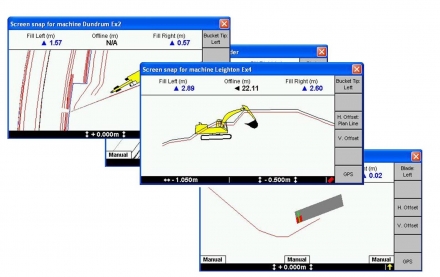
Is this correct? (2)
Is this correct?
- Use the wireless system to acquire screen snaps of the machine's current display.
Useful for such things as:
- Able to compare what operator is viewing vs current survey design model to confirm accuracy.
- Checking operating correctness and diagnose correct system options.
Traditionally, we have had to be at the machine viewing the error on-screen and then relaying this, usually by phone, to someone in the office to check against the design. With screen snaps, we can gain a good understanding of the operators concerns and compare it on the same PC in the office.
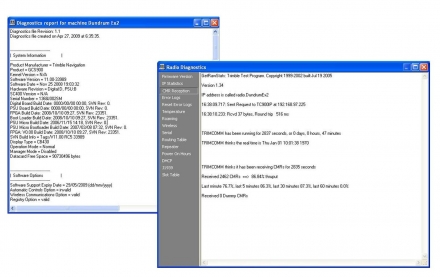
Something is wrong.
Something is wrong.
Receive diagnostic reports:
- Receive diagnostic reports from the GPS system on specific hardware information and operator settings.
- Receive diagnostic reports from machine radio.
- Retrieve program log files for advanced Trimble support.
Useful for such things as:
- Diagnosing hardware problems.
- Checking operator settings.
- Investigating radio related issues such as CMR throughput, radio temperature and error logs.
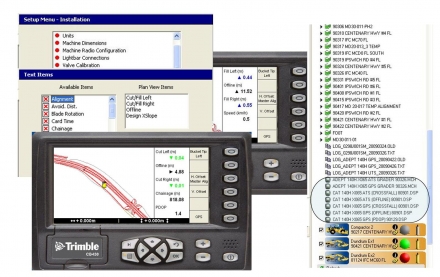
We need more.
We need more.
Machine Setting Files:
- Re-configure machine setting files for various operator preferences and/or operating requirements .
- Amend file in the office and re-send to machine for loading.
Useful for such things as:
- A grader wishing to view current blade crossfall in order to build a level kerb pad.
- An excavator wishing to view chainage in order to allow for differing pavement box depths.
- The survey department wishing to change the machines GPS radio channel when moving to different work areas.
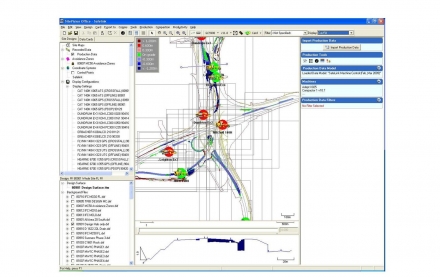
Receiving machine data.
Receiving machine data.
Acquire machine production data:
- Machine data is sent back to the office every 5 mins and automatically processed within SVO.
Useful for such things as:
- Easily viewing specific data on such things as:
- Current ground elevation.
- Current cut/fill against any design.
- Machine pass counts.
- GPS accuracy modes across the site.
- Machine radio latency in specific work areas.
All this information can give an almost real-time snap shot of the jobs progress and/or help in diagnosing specific GPS problems. There are also a number of filter options that can be applied to the data such as machines, specific times, geographic boundary lines, etc. This data can be viewed with the SVO program or exported.

Benefits of Wireless Communication
- The ability to easilty maintain machine data cards with latest design info - all from the office.
- This includes updates in design files & deletion of superceded files to ensure that all intended design changes are available to the field.
- Faster response times.
- Electronic design transfers that all-but eliminate the need to drive out to individual machines. On a site like Safelink that had numerous work areas split by existing motorways - most of which are relatively confined and difficult to access - to visit all 22 GPS machines would easily take a whole day.
- Increased service levels.
- Tools that assist in diagnosing both system and operator setting errors from the office and even allow easy configuration of new operator settings for various preferences or specific operations
- Ability to acquire almost real-time machine data.
- Gain a better understanding of how the machine and the site is operating.

Results of Wireless Communication
The outcome of all these benefits are :
- Less machine downtime.
- Less card delivery time for survey.
- Hence less required manpower.
The end results of all this is, quite simply, lower costs and shorter project times. The use of wireless communications between machines and a centralised office location has and will assist in the ultimate aim of delivering projects on-time and within budget.

Return to Articles Menu


